Comparison of Western, Tropical, and Couch's kingbird characters.
All photographs © Kevin and Jay McGowan, unless otherwise noted.
The common yellow-bellied kingbirds found in the western United States can be readily identified by their tail patterns and calls. (Western Kingbird has white outer tail feathers; Cassin's has a white tip to the tail; Tropical and Couch's lack white in the tail and have larger bills.) However, sometimes the birds don't call, and sometimes things are confusing. Cassin's always has a darker gray head, back and breast, with a contrasting white malar stripe. This page was stimulated by the appearance of a kingbird in upstate New York in November 2003 that showed a number of mixed characters. (For photos of this bird and a discussion, go here.)
I examined and photographed a number of specimens in the Cornell University Museum of Vertebrates, and found some variability that field guides have a hard time showing, as well as some interesting other little details.
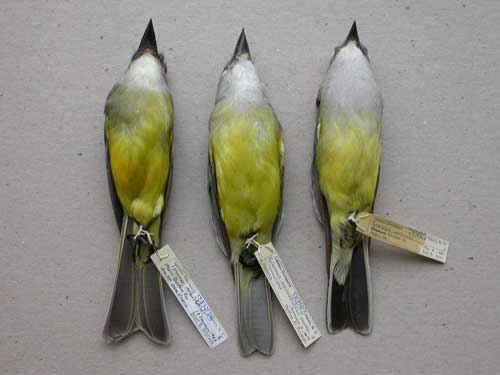 These are "typical" specimens of Tropical (from Mexico) (Left), Couch's (Center), and Western (Right) kingbirds from the Cornell collection. Note the brighter yellow bellies of the Tropical and Couch's, with a band of darker olive green across the chest. The Western has a dusky gray chest. All the species have slightly notched tails, but the notch is most pronounced in the Tropical. |
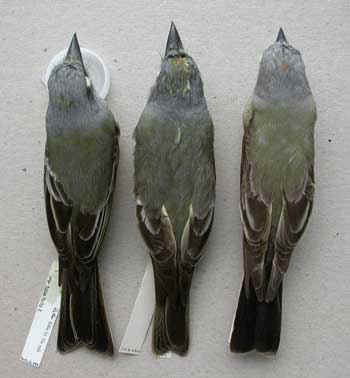 The same specimens from the back: Tropical (L), Couch's (C), and Western (R). Note that all have gray backs washed with olive, although the extent of the green varies. All have extensive whitish edging to the tertials and secondaries. Only Tropical and Couch's have whitish edging extending up the length of the tail feathers. Fresh tail feathers in Tropical and Couch's can appear quite blackish, although they do not approach the true black of the Western's tail. |
 Western has a shorted and less massive bill than the other two species, and Couch's is slighter than Tropical's. All have a slightly darker area in front of the eye and behind it. I can see no differences in this character with these specimens. |
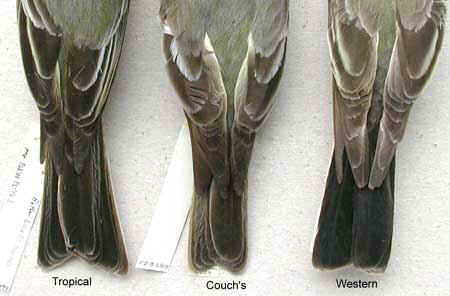 Here is a close-up of the tails and wingtips. I lightened this photo dramatically and shifted the gray in order to allow the wingtips to be seen. With the exaggerated color, the differences in black and blackish can be seen. Note the wing feathers of Tropical and Couch's match the blackish of the tail, while Western's blackish wings do not approach the true black of the tail. The distance from the folded secondaries to the tip of the wing (primary extension) is short in the Tropical Kingbird, moderate in the Couch's, and long in the Western. |
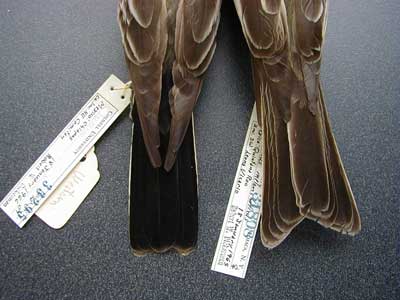 Both Couch's and Tropical kingbirds show extensive white or whitish edging up the length of the tail feathers, while this character seems not to be shown in Western. These two specimens of Western (L) and Tropical (R) were both collected on 18 January (one year apart), and look roughly to have about the same amount of wear (very little).
|
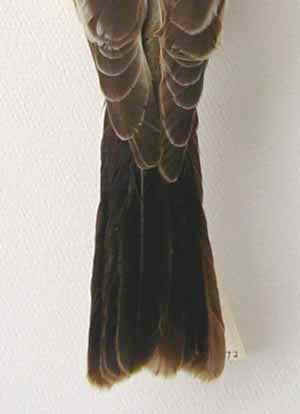 This is the tail of an immature Western Kingbird, taken in Sonora, Mexico on 20 September 1952, and is just about the freshest feather we have for the species. Note that a faint pale edge is visible along the central feather, but it is concentrated mostly at the tip, and no pale edging is visible up the feather. |
|
|
|
| Tropical Kingbirds can show white on their outer
tail feathers.
This is a Tropical Kingbird specimen from Brazil. It had the largest white edge to the outer tail feather of any of the species in our collection. Note that it is distinctly white, but that the white does not penetrate medially to the feather shaft. |
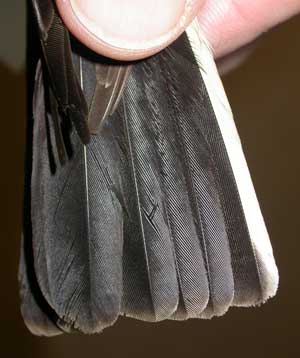 This is an adult Western Kingbird, showing that the white encompasses the entire outer vane of the outermost tail feather. Sometimes the tip of the outer feather has a dusky tip. |
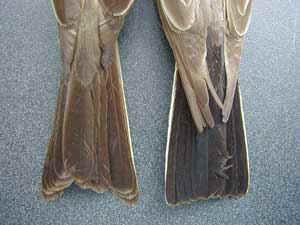 This photos compares the white edge on the Tropical Kingbird with that on a Western. The Tropical is white, but it does not stand out nearly as distinctly as the Western's. |
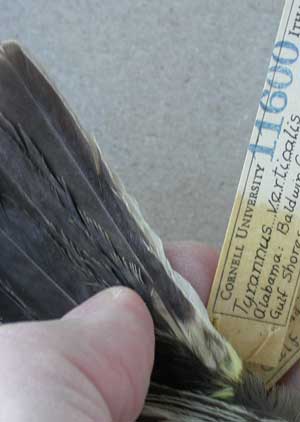 |
 |
| I found that most Western Kingbirds had white only on the outer vane of their outermost tail feather (r6), but than perhaps a third had some white at the base of the inner vane of r6. Only a very few had any white on the next feather in (r5). This specimen had the most white on the inner vanes that I found in the Cornell collection. | |
| Bill shape differs between the species.
Although the angles of these specimens are not identical, this photo shows the comparative bill sizes of the three species. Western has a relatively short bill, Couch's is longer, and Tropical is longest and thickest. |
||
|
This photo shows the extreme of Western Kingbird bill size in the Cornell Collection. |
| All three kingbird species have differently-shaped wings. The Western Kingbird, as the most migratory of the bunch, has longer and more pointed wings. This difference can be seen in the long projection of the primaries out from the secondaries in the folded wing. Tropical Kingbird (in all subspecies that I have looked at) has a rather stubby projection. Couch's is intermediate, but more like Tropical than Western. (See the lightened photo, above.) The primaries are differently shaped too, with those of Western being long and thin, and Tropical and Couch's being broader with more distinct notches on the inner vane. Western's are notched too, but the notch is slight and elongated. These differences are most distinct on the adult males. Adult females have much less exaggerated feather shape, with less noticeable notches. Juvenal primaries are broader and mostly lack notching, looking more like "normal" bird feathers.
|
||
|
Fig. 6. Couch's Kingbird adult male wingtip. |
Tropical Kingbird wingtip (probably adult male). |
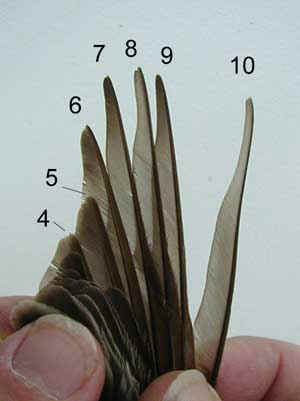 Western Kingbird adult male wingtip. |
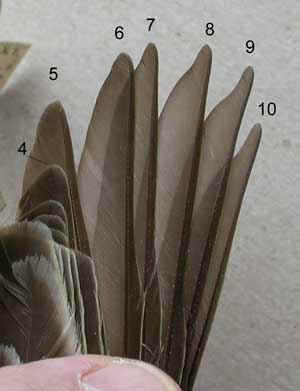 Fig. 8. Couch's Kingbird adult female wingtip.
|
 Tropical Kingbird adult female wingtip. |
 Western Kingbird adult female wingtip. |
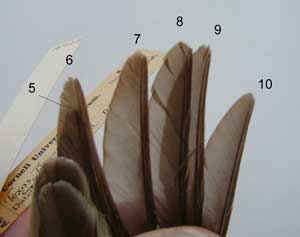 Fig. 9. Couch's Kingbird juvenal wingtip.
|
|
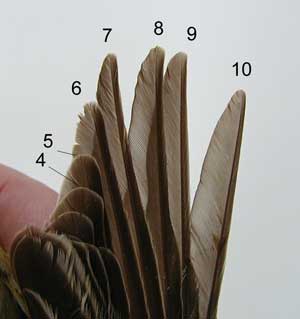 Fig. 10.
Western Kingbird juvenal female wingtip. Fig. 10.
Western Kingbird juvenal female wingtip.
|
For comparison purposes, here is the mystery kingbird from Livingston Co., NY, November 2003.
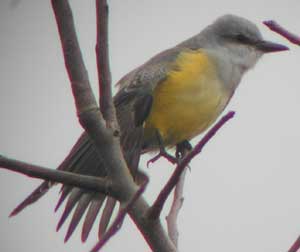 |
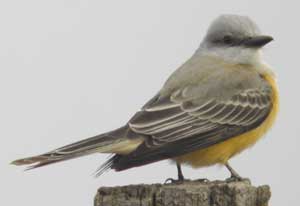 |
|
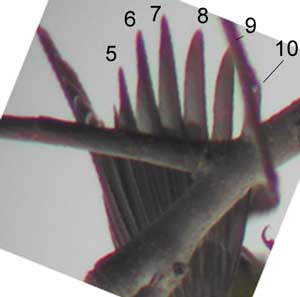 This is the wingtip
of the Livingston Co., NY bird, courtesy of Willie D'Anna. I have flipped and
rotated the photo for comparison. purposes. This is the wingtip
of the Livingston Co., NY bird, courtesy of Willie D'Anna. I have flipped and
rotated the photo for comparison. purposes. |
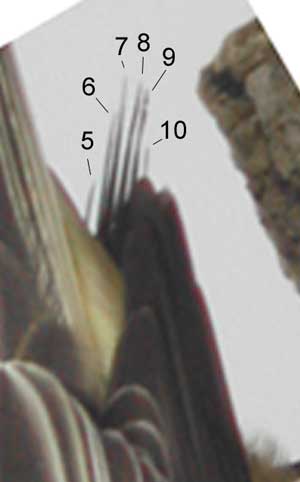 Here is another view of the wingtip of the Livingston Co., NY bird, courtesy of Willie D'Anna. I have flipped and rotated the photo for comparison. |
|
 |
 |
|
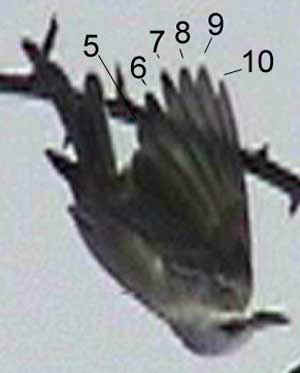 |
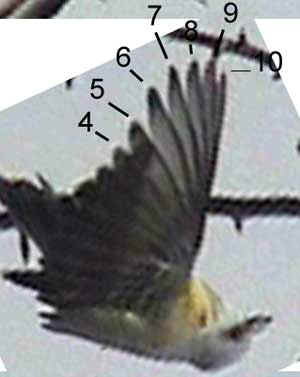 |
|
| Here is a nice cautionary note for those trying to deduce wing formula from photographs. The two video captures above show the wing of the bird fully extended and partially retracted. To my eye the fully extended wing shows a rather long p10, much longer looking than p6, and p9 longest. With the wing partially closed p6 now looks longer than p10 and you can get a hint that p7 is really the longest one. When people talk about wing formula, it should always pertain to the FOLDED wing. Pyle (1997. Identification Guide to North American Birds; p. 9) says, "When performing wing morphology measurements, however, it is important that the wing be closed and in its natural position." From Willie D'Anna's photograph of the closed wing (shown above), we can see that p6 is actually much longer than p10, and that p7 is indeed longest. All of the specimen photos shown here represent the folded wing with the feathers spread only wide enough to see the feathers tips. (The wing is dried closed, so they can't be spread without breaking something.) |
 |
|
Return to the Bad Photos page.
Return to Kevin McGowan's home page.
Go to the Crow Page.
Go to the Cornell Lab of Ornithology's home page